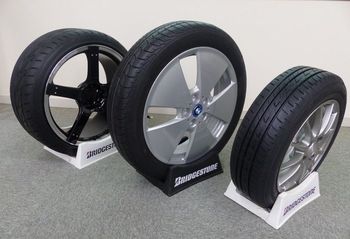
The BMW i3 was released in Europe in November 2013 as BMW’s first electric vehicle. The futuristic vehicle has excited interest with its lightweight yet expensive carbon fiber body, coach doors, and use of natural materials.
Though it is not widely known, Japanese technology made a contribution. The tires fitted on the i3 possess some unique characteristics.
High performance tires
They are slim at just 155 millimeters wide, but the inner diameter is 19 inches, comparable to SUVs or full-size sedans. This combination of narrow width and large diameter is not found in other vehicles. It is not simply the shape that is unique; compared with other existing high fuel economy tires, the rolling resistance is 30% lower, and the grip performance wet road surfaces is 8% higher.
These tires, named “Ologic”, were developed by Bridgestone. A team including Hiroyuki Matsumoto (Tire Research HQ Driving Stability Research Unit Leader) and Isao Kuwayama (Stability Research Fellow), who were responsible for R&D of F1 racing tires—from which Bridgestone withdrew in 2010, applied their accumulated technical expertise, spending nearly seven years on the development.
“I pursued the ultimate form for tires,” said Unit Leader Matsumoto, and the answer that lead him to a breakthrough was a narrow-width large-diameter shape that no existing tires possessed. Generally, decreasing the tire width reduces air resistance and improves fuel economy. However, decreasing width has a number of demerits, such as reduced grip.
The solution to these issues was threefold: increasing rigidity, developing a new tread pattern, and increasing the diameter. These three measures were part of a complex equation with various tradeoffs. Using their unique measuring system, they produced a tire that minimizes demerits while maximizing merits.
There is just one major problem remaining. Due to the unique size of the tires, they cannot be mounted on existing vehicles. However, BMW adopted these tires for the entirely new electric vehicle it developed. The i3 was developed presupposing the use of these tires as standard equipment.
By fitting them on BMW’s electric vehicle, this new type of tire was able to draw a certain degree of publicity. In fact, they have received inquiries from several manufacturers. How far they will be able to expand their use as standard equipment still remains to be seen. The sales methods differ significantly from preceding tires, such as requiring collaboration with automakers from the body design stage.
Fellow Kurayama says, “We are going to keep on raising the performance level by level.” In the ever-intensifying competition over fuel economy, both foreign and domestic automakers may turn their eyes to Bridgestone.

